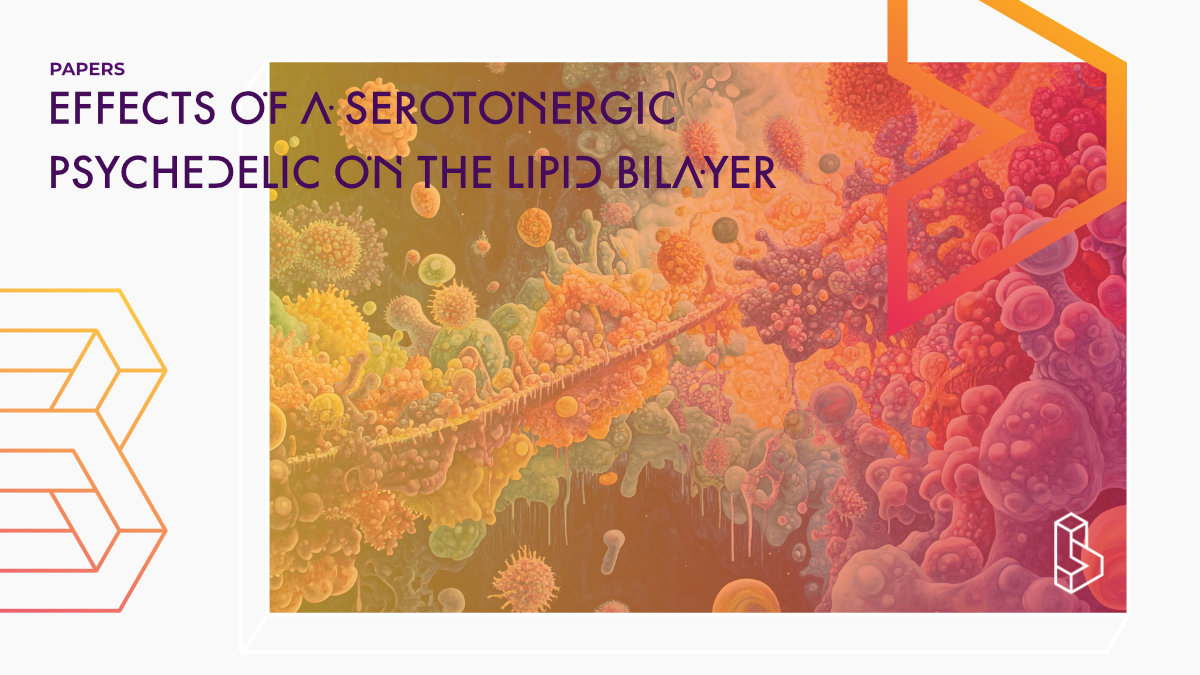This lab study used different ways of looking at cells to see how the psychedelic drug DOI affects the outer layer of cells (lipid membrane). The study found that DOI is over 100 times stronger than serotonin at disrupting the cell’s outer layer, helping small bubble-like structures combine with cells, and making it easier for tiny holes to form in cell membranes. This suggests that psychedelics might affect the brain not just by binding to receptors (their usual known method), but also by physically changing how cell membranes work and help create new connections.
Abstract of Effects of a Serotonergic Psychedelic on the Lipid Bilayer
“Serotonergic psychedelics, known for their hallucinogenic effects, have attracted interest due to their ability to enhance neuronal plasticity and potential therapeutic benefits. Although psychedelic-enhanced neuroplasticity is believed to require activation of 5-hydroxytryptamine (serotonin) 2A receptors (5-HT2ARs), serotonin itself is less effective in promoting such plasticity. Also, the psychoplastogenic effects of these molecules correlate with their lipophilicity, leading to suggestions that they act by influencing the intracellular receptors. However, their lipophilicity also implies that a significant quantity of lipids is accumulated in the lipid bilayer, potentially altering the physical properties of the membrane. Here, we probe whether the serotonergic psychedelic 2,5-dimethoxy-4-iodoamphetamine (DOI) can affect the properties of artificial lipid bilayers and if that can potentially affect processes such as membrane fusion. Solid-state NMR spectroscopy shows that the DOI strongly induces disorder in the lipid acyl chains. Atomic force microscopy shows that it can shrink the ordered domains in a biphasic lipid bilayer and can reduce the force needed to form nanopores in the membrane. Fluorescence correlation spectroscopy shows that DOI can promote vesicle association, and total internal fluorescence microscopy shows that it enhances vesicle fusion to a supported lipid bilayer. While serotonin has also recently been shown to cause similar effects, DOI is more than two orders of magnitude more potent in evoking these. Our results suggest that the receptor-independent effects of serotonergic psychedelics on lipid membranes may contribute to their biological actions, especially those that require significant membrane remodeling, such as neuronal plasticity.“
Authors: Debsankar Saha Roy, Ankit Singh, Vidita A. Vaidya, Daniel Huster, Kaustubh R. Mote & Sudipta Maiti
Summary of Effects of a Serotonergic Psychedelic on the Lipid Bilayer
This study explores how serotonergic psychedelics, specifically 2,5-dimethoxy-4-iodoamphetamine (DOI), interact with and alter lipid membranes, potentially contributing to their neuroplastic effects. Psychedelics like DOI, psilocybin, and LSD are known for activating 5-HT2A receptors to produce hallucinogenic effects and promote structural plasticity in neurons. However, unlike serotonin, these compounds are highly lipophilic (fat-soluble), enabling them to integrate into the lipid bilayer of cell membranes. The study hypothesises that this integration might alter the physical properties of membranes, possibly affecting cellular processes like membrane fusion—an essential function for neural plasticity. This research specifically investigates the effects of DOI on artificial lipid bilayers, assessing whether it alters membrane properties and interactions independently of receptor activation.
Membrane Partitioning and Lipid Interaction
Serotonergic psychedelics’ ability to permeate lipid membranes due to their lipophilicity means a substantial amount of these compounds may remain within the lipid bilayer. The study compares DOI’s effects on lipid membranes to those of serotonin, focusing on whether DOI changes membrane order, stiffness, and other physical properties that may contribute to neuroplasticity. Previous studies have shown that serotonin and similar compounds can influence membrane mechanics, such as reducing membrane stiffness and altering lipid domain structure, suggesting similar, possibly stronger, effects for DOI due to its higher lipophilicity.
Results and Discussion
DOI and Lipid Membrane Partitioning
DOI’s strong lipophilicity enhances its interaction with lipid bilayers. The study confirms this through a partition coefficient experiment, showing that DOI integrates more efficiently into lipid membranes compared to serotonin. Despite serotonin’s ability to affect membrane properties, DOI exhibits more pronounced effects at significantly lower concentrations.
Changes in Lipid Chain Order and Membrane Stiffness
Find this paper
Effects of a Serotonergic Psychedelic on the Lipid Bilayer
https://doi.org/10.1021/acschemneuro.4c00484
Paywall | Google Scholar | Backup | 🕊
Cite this paper (APA)
Roy, D. S., Singh, A., Vaidya, V. A., Huster, D., Mote, K. R., & Maiti, S. (2024). Effects of a Serotonergic Psychedelic on the Lipid Bilayer. ACS Chemical Neuroscience.

